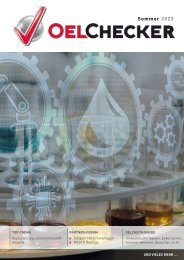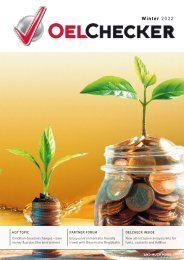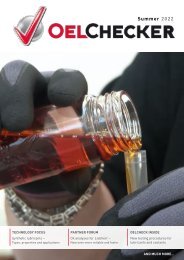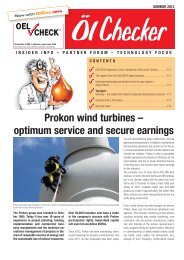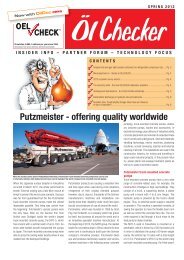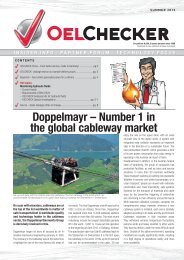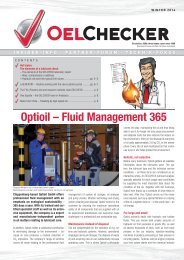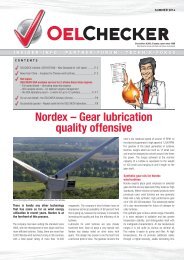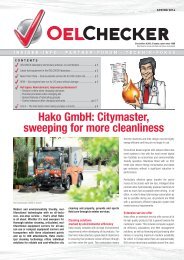OELCHECKER - Winter 2012
> OELCHECK China – Getting ready before the new laboratory opens > OELCHECK Laboratory – quicker and more accurate with a new particle counter > Hot Topics: The analysis of lubricating greases > Correct sampling > Most important analysis methods > Experience of our experienced tribologists > In demand – optimising online documentation of laboratory reports > and much more...
> OELCHECK China – Getting ready before the new laboratory opens
> OELCHECK Laboratory – quicker and more accurate with a new particle counter
> Hot Topics: The analysis of lubricating greases
> Correct sampling
> Most important analysis methods
> Experience of our experienced tribologists
> In demand – optimising online documentation of laboratory reports
> and much more...
Create successful ePaper yourself
Turn your PDF publications into a flip-book with our unique Google optimized e-Paper software.
OELCHECK Insider Info<br />
The OELCHECK laboratory -<br />
quicker and more accurate with a new particle counter.<br />
Almost 80% of all hydraulic failure<br />
can be traced back to impure oil. In<br />
order to lubricate other components,<br />
which are produced with an increasing<br />
level of precision, the purity and<br />
cleanliness of oil is of increasing importance.<br />
In order to better predict<br />
how much longer oil can be used for,<br />
the particle count of over 600 oil samples<br />
is carried out in the OELCHECK laboratory<br />
on a daily basis. The four counting<br />
systems, which are equipped with specimen<br />
change-over facilities, often run<br />
at full capacity, which is why we have<br />
installed an additional innovative particle<br />
counter. It has not just made the<br />
work of the laboratory technicians easier,<br />
but has also sped up work flow.<br />
Impurities in oil can always be a risk. Hard particles<br />
such as dust, coloured particles and wear metals<br />
can cause abrasive wear. Soft particles can build<br />
up from old additive components. Often they are<br />
adhesive too and stick to machine parts or filters,<br />
which prevent them from functioning smoothly.<br />
Particles in oil accelerate the ageing of oil and<br />
shorten its lifespan.<br />
Particle counting and<br />
optical particle analysis<br />
Particularly when checking hydraulic, turbine and<br />
other low-viscosity oils, the pollution level is determined<br />
based on ISO 4406 by counting the size and<br />
number of particles in the laboratory with help from<br />
automatic particle counters (APC). The level of pollution<br />
is divided up into purity categories. Here, laser<br />
sensors are used to determine the number and size<br />
of the particles. After the particles are counted,<br />
the oil is classified according to purity. The processes<br />
used to determine oil purity and purity categories<br />
are defined under ISO 4406 and SAE 4059.<br />
ISO 4406 classification is based on particle sizes<br />
>4 µm, >6 µm and >14 µm. The ISO particle numbers<br />
are cumulative, which means that the stated<br />
particle figure for > 6 µm consists of all particles<br />
>6 µm plus particles >14 µm.<br />
Detailed information about purity categories can<br />
be found at www.oelcheck.de under Downloads,<br />
ÖlChecker, Summer 2000, pages 6-7.<br />
Conventional particle counting only distinguishes<br />
between the size and number of particles, however.<br />
It does not record whether they are soft or hard<br />
particles. Water droplets, small air bubbles and<br />
The innovative particle counter in the OELCHECK laboratory already offers clear-cut advantages.<br />
soft particles are thus recorded too. OPA, optical<br />
particle analysis, provides more precise information<br />
on gear oils. It also photographs the outline of<br />
particles and divides them into specific categories<br />
such as wear fatigue, cutting wear, non-metal impurities<br />
(tribopolymers), water droplets and so on.<br />
The number and size of particles are recorded during<br />
the particle counting process too.<br />
The new particle counter offers<br />
distinct advantages<br />
In principle, the new generation particle counter<br />
in the OELCHECK laboratory works like existing<br />
devices with a laser sensor, but the samples<br />
are now homogenised and prepared better. The<br />
entire process has been simplified and optimised.<br />
In the conventional particle counting process,<br />
air bubbles and water droplets can influence the results.<br />
The new device rules out this possibility in the<br />
majority of cases.<br />
Particle counting is one of the first stages of analysis<br />
an oil sample undergoes. Previous machines<br />
analysed the sample directly from the original<br />
container. As counting can take up to 5 minutes,<br />
this may lead to delays further along the testing<br />
process, because too many samples get backed up<br />
as they wait to be counted. Now laboratory assistants<br />
pour only 20 ml approximately of the homogenised<br />
sample into a plastic beaker, which goes into<br />
the new counter. Afterwards the sample container<br />
is immediately transferred to the next examination<br />
stage, which of course reduces processing times.<br />
Instead of only 20 samples, the new device can<br />
be loaded with 80 sample containers. Before the<br />
actual counting, an innovative ultrasound sensor<br />
determines the exact size of the sample so that<br />
an exact solvent mixture of 75% toluene and<br />
25% propanol at a ratio of 2:1 (based on ASTM<br />
D7647-10) can be used and this can be taken into<br />
account to determine a blind value. Immediately<br />
before the measurement, the sample is homogenised<br />
and degassed. Air bubbles escape quickly<br />
from the diluted sample and can therefore no<br />
longer be counted in the analysis. The effect of<br />
the propanol in the solvent mixture is that possible<br />
water droplets dissolve and become „invisible“.<br />
In addition, the toluene dissolves any soft reaction<br />
products which may be present and ensures that<br />
only the hard particles which are actually present in<br />
the oil are counted.<br />
The entire diluted sample of around 30 ml is then<br />
counted three times in a row, from which a mean<br />
average is extrapolated. If the individual values differ<br />
from each other greatly, the particle counter rejects<br />
the whole analysis and requests a new specimen.<br />
It doesn‘t get much more precise than that!<br />
A Canadian company is behind our new particle<br />
counter. The core of the machine, the particle<br />
sensor, comes from Markus Klotz GmbH. In<br />
the OELCHECK laboratory, the innovative particle<br />
counter has already proven itself to be highly<br />
effective. Each day it looks at some 250 samples<br />
and is set to be joined by a second device of the<br />
same make soon.<br />
3




